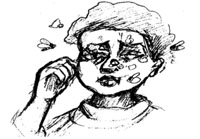Self-Assessment Questions (SAQs) for Study Session 39
Now you have completed this study session, you can assess how well you have achieved its Learning Outcomes by answering the following questions. Some of the questions test your knowledge of earlier study sessions in this Module. Write your answers in your Study Diary and discuss them with your Tutor at the next Study Support Meeting. You can check your answers with the Notes on the Self-Assessment Questions at the end of this Module.
SAQ 39.1 (testing Learning Outcomes 39.1, 39.2, 39.3 and 39.4)
Which of the following statements is false? In each case, explain what is incorrect.
A Zinash is a 16-year-old girl who has had eye problems for the last four years. There are white bands inside her swollen red eyelids. You should immediately refer her to hospital.
B A newborn with red and swelling conjunctiva should be treated by putting tetracycline ointment into the eyes.
C Corneal opacity is reversible through treatment with tetracycline ointment.
D Scabies can be treated successfully with tetracycline ointment.
E The SAFE strategy for preventing trachoma stands for surgical treatment, antibiotics, face washing and environmental sanitation.
F Disability resulting from podoconiosis and lymphatic filariasis can be reduced by foot and leg hygiene, exercising the affected part and raising the legs when sitting or sleeping.
G Trachoma, scabies and podoconiosis are all communicable diseases found in conditions of poverty, overcrowding and poor access to clean water and sanitation.
Answer
A is true. Zinash has scarring of the conjunctiva (white bands inside the eyelids), i.e. trachoma grade TS. Therefore, she should be referred to hospital for surgical treatment.
B is true. A newborn with red and swollen conjunctiva could have got the infection from its mother during birth and should be treated with tetracycline eye ointment (1%).
C is false. Corneal opacity is a permanent type of damage and cannot be improved by treating with tetracycline ointment.
D is false. Scabies is caused by a parasite and can’t be treated by tetracycline ointment, which is used to treat grade TF and TI trachoma. A child with scabies should be treated using BBL lotion.
E is true. The SAFE strategy for preventing trachoma stands for surgical treatment, antibiotics, face washing and environmental sanitation.
F is true. Disability resulting from podoconiosis and lymphatic filariasis can be reduced by foot and leg hygiene, exercising the affected part, and raising the legs when sitting or sleeping.
G is false. Podoconiosis is not a communicable disease – it is caused by contact with red clay soils, not an infectious agent. However, trachoma and scabies are communicable diseases found in conditions of poverty, overcrowding and poor access to clean water and sanitation.
SAQ 39.2 (testing Learning Outcomes 39.3 and 39.4)
If you see a girl with discharge coming from her eyes and flies landing on her face (Figure 39.19), what should you advise her family?

Answer
The family of the girl should be educated about face washing with soap and clean water every day to remove the eye discharges. Tell them that the presence of eye discharge and poor personal hygiene will transmit trachoma bacteria to other people through flies landing on the face, and dirty hands and clothing touching the eyes.
SAQ 39.3 (testing Learning Outcomes 39.1, 39.2 and 39.3)
Name at least three communicable diseases that can result in blindness. In each case, briefly state the cause of the eye problems.
Answer
Measles, onchocerciasis and trachoma are the three major communicable diseases that can cause blindness. In Study Session 3 of this Module, you learned that measles can cause blindness, particularly among malnourished children who are lacking vitamin A. In Study Session 37 you learned that onchocerciasis can affect the eyes and cause so-called ‘river blindness’ because the insect vector (blackflies) needs fast-flowing water to breed. Trachoma causes blindness due to corneal damage resulting from bacterial infection of the conjunctiva.
SAQ 39.4 (testing Learning Outcomes 39.2, 39.3 and 39.4)
How many diseases can you remember learning about in this Module where the symptoms are at least partly caused by allergic reactions by the patient’s immune system to foreign material getting into the body?
In each case, briefly describe the foreign material.
Answer
Several of the communicable diseases you have learned about in this Module have clinical manifestations that are due to allergic reactions by the patient’s immune system to foreign material introduced into their bodies. The foreign material may be the infectious agent itself: for example, in tuberculosis, leprosy, schistosomiasis, leishmaniasis, onchocerciasis, lymphatic filariasis and trachoma – or the allergic reaction may be to scabies mites. You may also have noted that the allergic reaction to body lice bites causes itching and scratching, which enables the infectious agents of relapsing fever and typhus to enter the body through breaks in the skin. Podoconiosis is due to an allergic reaction to red clay soils penetrating the skin of bare feet.
Summary of Study Session 39
